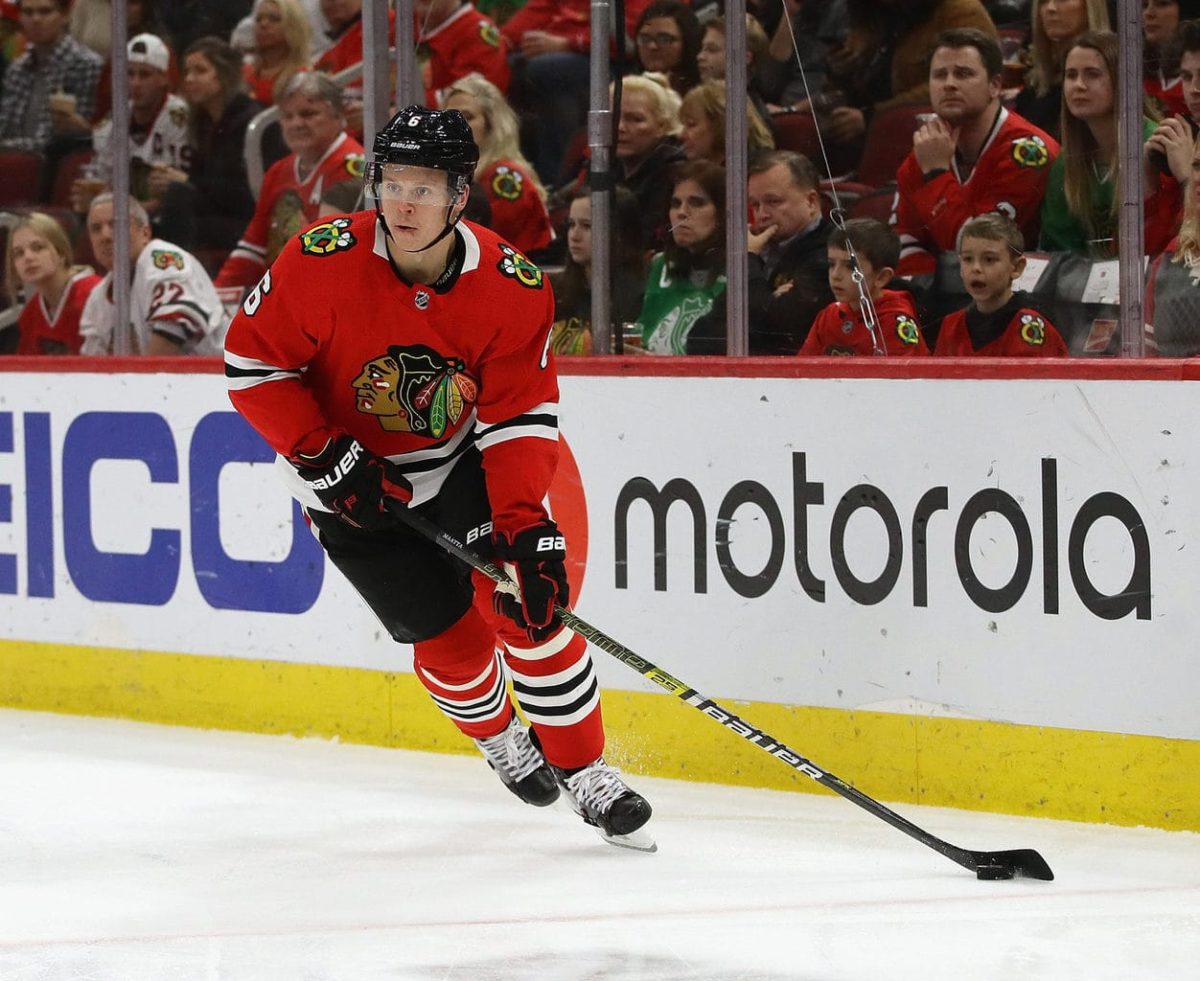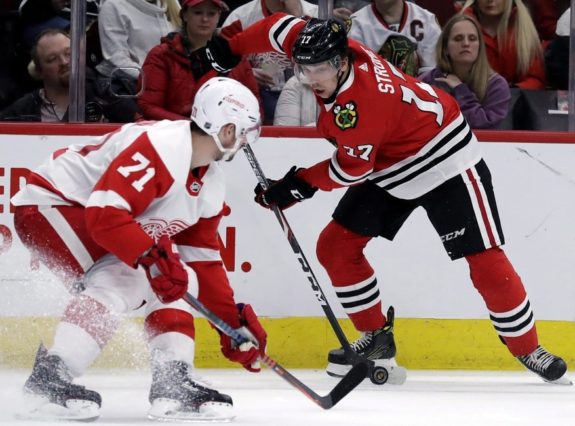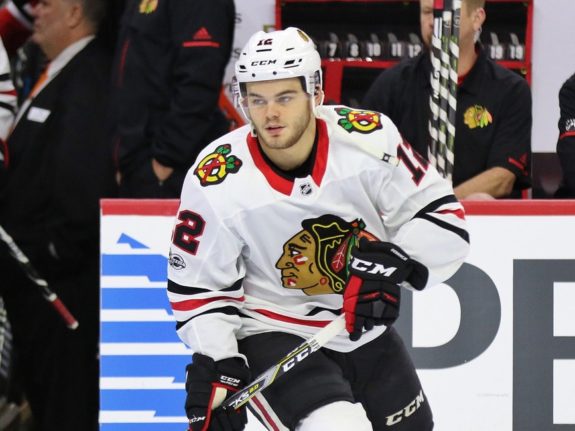Let’s face it, it’s no surprise the Chicago Blackhawks were eliminated from the 2020 playoffs by a much deeper Vegas Golden Knights’ team. As a matter of fact, many thought Chicago would be knocked out by the Edmonton Oilers in the qualifying round. But a few Blackhawks’ players stepped up with some surprising statistics to help their team find unexpected success. On the other hand, a couple of players also did not contribute as expected. Here are my top five player surprises from the Blackhawks’ 2020 playoff campaign.
5. Maatta’s Impressive Impact
As expected, core veterans Jonathan Toews and Patrick Kane led the way in the postseason, each with nine points. And it’s no surprise Toews’ first line partner in crime and Calder Trophy finalist Dominik Kubalik came in second with eight points. But did anyone expect defenseman Olli Maatta to tie Alex DeBrincat and Kirby Dach for third place?! Sure enough, all three players recorded six points, and Maatta actually carried the edge because he scored the most goals (three).

Maatta didn’t exactly light the world on fire during the regular season. He amassed four goals and 13 assists and an even plus/minus rating in 65 games. Sure, as a third pairing defenseman he’s not exactly expected to contribute offensively. But like the entire defensive corps, Maatta struggled with his assignments, and even suffered the healthy scratch treatment by head coach Jeremy Colliton. Many questioned whether he would have been signed in the first place if the Blackhawks had known they were also going to acquire defenseman Calvin de Haan.
But Maatta also won two Stanley Cups with the Pittsburgh Penguins, and suited up for 60 playoff games with his former team. That experience, and his continued growth within Colliton’s system, paid off in Maatta’s nine postseason games with the Blackhawks. Especially in the qualifying round against the Oilers, the Blackhawks concentrated on having the defensemen contribute offensively as much as possible.
Maatta did just that, notching two goals in four games against the Oilers. It was also his initial shot which was deflected by Brandon Saad for a goal in Game 1. And he earned a secondary assist in Game 3 when his defensive partner Slater Koekkoek provided a similar shot redirected by Matthew Highmore. Maatta further contributed another goal and a primary assist against the Golden Knights.
This might all be a moot point, as the Finnish defenseman is considered a primary candidate for a buyout. His contract is buyout friendly, his cap hit is a fairly costly $4.1 million for the next two years, and a number of younger, cheaper defensive prospects are in the Blackhawks’ pipeline. (Source: ‘Olli Maatta’s offensive surge in playoffs could complicate Blackhawks’ buyout situation’, The Chicago Sun-Times – 8/18/20)
Chances are Maatta won’t be in Chicago this coming season. Regardless, his success and intensified play was a good example to the rest of the team of what it means to step up when it matters.
4. Highmore Provides Depth
Like Maatta, forward Highmore unexpectedly stepped up offensively for the Blackhawks as well. The 24-year-old was brought up from the AHL’s Rockford IceHogs in late November of 2019, coinciding with Drake Caggiula’s absence due to a concussion. Highmore found his place in the regular lineup on the fourth line, mostly playing alongside Ryan Carpenter and David Kampf.

Sure enough, this was his spot in the playoffs as well. He ended up contributing three goals and an assist in his nine-game playoff debut. Not bad production for a fourth liner. But what’s really impressive is the way Colliton raved about Highmore in his postseason presser. Bear with me; this is a long quote, but it speaks volumes.
He (Highmore) doesn’t play 25 shifts in a game, but the shifts he gets, he knows exactly what he’s supposed to do. He goes out there, he does it 100 miles an hour, he doesn’t cheat, he wins 50-50s, he advances the puck, he gets it in, he goes to the net. That line scored three or four goals, at least, in the series playing against top-line competition and it’s just because he’s willing to do the right thing.
I thought the other guys did too, and then he gets off. He doesn’t extend his shift, he doesn’t hang around in the offensive zone hoping to get a goal or get a second assist or get a plus [rating]. If he started in D-zone, he gets it out of D-zone, gets it in and 35 seconds in, the alarm bells are going off in his head that he’s got to get off so that Patrick Kane can step on in a good spot, maybe playing against tired guys in the offensive zone or on an offensive zone faceoff.
We need more of that. We need it up and down the lineup, and we’ll be a much better team defensively because we’ll be defending when we’re fresh, we’ll have a better forecheck because we’re forechecking against tired guys, we’ll draw more penalties, you build energy in your group because you see people making team decisions and having a team-first mentality. And that’s how you win.
Again, that’s effusive praise by the head coach. Let’s hope Highmore can carry his success and strong work ethic into the 2020-21 season.
3. Strome’s Improvement on Faceoffs
When Dylan Strome joined the Blackhawks via trade in late November 2018, he thrived with his new team. Reunited with old OHL buddy, DeBrincat, Strome recorded 17 goals and 34 assists in 58 games. Based on this very productive first season with the Blackhawks, Strome was unofficially penciled in as the new second line center behind Toews.
But the young man’s 2019-20 campaign was not as successful. Strome registered only 12 goals and 26 assists, coincidentally also in 58 games played. The emergence of rookie Dach on the scene leaves many questioning whether Strome has become dispensable. After all, he is now a restricted free agent headed into next season.

One area where Strome has seen improvement is at the faceoff circle, and none more than when it really counted in the playoffs. In his two seasons with the Blackhawks, Strome had a combined faceoff percentage of 46.2%. Ideally a second line center should be over 50%.
But in the playoffs Strome’s faceoff percentage rose to 51.4%. And although he ended up being demoted to third line center while Dach took over on the second line, Colliton trusted Strome with more draws. In their nine postseason games, Toews took 213 draws. Usually the trustworthy Kampf would be next in line, especially taking defensive zone faceoffs. But Kampf only took 85 draws, whereas Strome was second to Toews with 111. Incidentally, Dach was fourth with 81 faceoffs and a measly 30.9% success rate.
Yes, I know it’s a small sample size. And I know there’s more to being a good center than having success at the faceoff circle. Dach obviously has a higher overall ceiling than Strome. But it appears Strome is improving at faceoffs, which is something he can hang his hat on. Dach, on the other hand, still needs a lot of work in this area.
That, combined with Strome’s obvious chemistry with DeBrincat whenever they do play on the same line together, could provide more reason to re-sign the restricted free agent next season.
2. Keith’s Lack of Production
Now that we’ve explored some positives for the Blackhawks in their playoff run, it’s time to look at a few negatives. When we learned the Blackhawks had been gifted a trip to the postseason due to the pandemic-adjusted format, most assumed the veteran core players would naturally lead the way. As referenced above, both Toews and Kane finished tied for the most points on the team. 37-year-old defenseman Duncan Keith, on the other hand, left a lot to be desired.

Keith registered zero goals and only five assists throughout the postseason. He only had 10 shots on goal and seven hits. Oh, and a team-high 12 giveaways. But the most glaring statistic was Keith being on the ice for a whopping 21 goals against. This was seven more than second-place Connor Murphy, who was on the ice for 14 goals against.
Now in Keith’s defense, the first-pairing defenseman predictably had the most ice time of any other player, so of course he was put up against some of the toughest assignments. He also was tasked with babysitting his partner, rookie Adam Boqvist, who struggled mightily in his first playoffs.
Related – Blackhawks Needed Veteran Keith To Be More Impactful
But the eye test didn’t do Keith any favors either. He looked slow and sluggish out there. He lost his coverage and got caught standing around a lot. Keith may still be an effective defenseman in many ways, but he simply can’t carry the weight like he used to. His weaknesses were exposed in this postseason, instead of the other way around. He needs more help, support, protection out there. It will be interesting to see how the Blackhawks attempt to set Keith up for success next season.
1. DeBrincat’s Continued Struggles
Where has DeBrincat gone?! The “Cat” tallied 41 goals and 76 points in the 2018-19 season. That and a 52-point rookie campaign helped earn him a three-year extension worth $6.4 million this past October.
Since then, DeBrincat has been nearly invisible. This past season he only managed 18 goals and 45 points. In the postseason run, he finished with just two goals and four assists. And one of those goals was an freebie empty netter.

Many thought the 22-year-old would snap out of his slump as the season progressed. He didn’t. Then they figured he would have more of an impact in the playoffs. He didn’t. DeBrincat is only five-foot-seven and 165 pounds. This has proven to be a disadvantage for him, as he consistently gets pushed around and knocked off the puck. And he’s not exactly known for his defensive prowess. He needs to make up for it with his offensive ability and nose for the net.
In DeBrincat’s defense, he’s been moved up and down in the lineup and played on the third line the majority of the season. He’s been demoted to the second power play unit. He hasn’t had the luxury of playing with his buddy Strome as much, with whom he has natural chemistry.
Related – Blackhawks’ News & Rumors: Crawford, Wirtz, Kubalik, Shaw
But DeBrincat himself would tell you none of these things are an excuse. To his credit, he’s been working hard to provide chances for himself and his teammates. He finished the postseason with 27 shots on goal, which was second on the team to Kane (28 SOG). He was on the ice for seven goals for and only two goals against for a 77. 78 goals for percentage. This was the best on the team.
Hopefully DeBrincat’s struggles will only make him stronger moving forward. It certainly would be nice if he could break through to get the Blackhawks going next season.
The Blackhawks competed hard and made the most of their postseason run; some players more than others. There’s a lot to build on, but also a lot to correct. Let’s see if they can carry over the good and work on eliminating the bad as they look towards their 2020-21 season.
*All stats courtesy of Naturalstattrick.com and NHL.com